Organic Society
 |
 |
 |
 |
 |
 |
 |
The Assumption Day Horse Race in Sienna
There is a charming tradition in Sienna on the Feast of the Assumption that began in the medieval times and continues to our day, showing us the indissoluble link between the Feast and Catholic Tradition. Il Palio di Siena is a horserace that takes place in the main plaza of Sienna on the Feast of the Assumption (August 15) and is dedicated to the
Santa Maria Assunta, Queen and Patroness of the city.
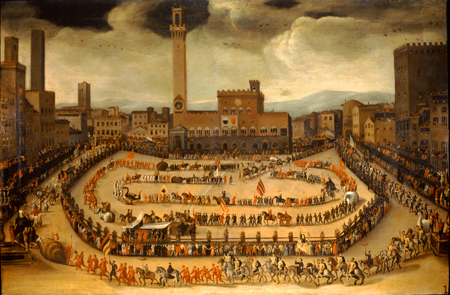 The pugnacious and militant spirit of the Italian medieval City State – with its own distinctive characteristics and style – gave rise to this race. Even today some of this spirit remains, with each rider “entering the battle” to come in first at the finish line, winning glory for his district.
The pugnacious and militant spirit of the Italian medieval City State – with its own distinctive characteristics and style – gave rise to this race. Even today some of this spirit remains, with each rider “entering the battle” to come in first at the finish line, winning glory for his district.
Each of the 17 contrade (districts) was formed organically as the different neighborhoods of the city were grouped around common churches, patron saints, trades and their histories. The contrade were given their names, symbols and flags to commemorate heroic acts of the people or memorable events.
One is the Contrada del Bruco (caterpillar district) whose inhabitants are specialized in silk, but they were given the title of nobility because of their heroism in defending Sienna from the Bohemians.
With such histories it is easy to understand why the people so passionately seek the victory for their contrada. This pride is carried into the races by the riders and bystanders alike as each man proudly dons his contrada's colors and ruthlessly calls for the defeat of the enemy contrade. This race also represents how the love of the medieval people for Our Lady found expression in colorful events. Let me look how it sprung up organically in this Italian city.
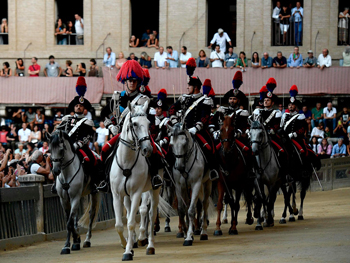 The original race was a race between the nobles in the 12th century that winded through the narrow streets of Sienna and ended at the grand black-and-white striped
Duomo Vecchio (Old Cathedral) at the center of the city.
The original race was a race between the nobles in the 12th century that winded through the narrow streets of Sienna and ended at the grand black-and-white striped
Duomo Vecchio (Old Cathedral) at the center of the city.
During the 13th century, the people desired to include the race in their celebration of the Blessed Virgin by moving the finish line to the Duomo Nuovo (New Cathedral), a cathedral dedicated to Santa Maria Assunta, and by offering candles and incense to the Virgin. In the 17th century, the race between the nobles was replaced by a race between the 17 contrade. The people of Sienna felt the need to express their devotion to Our Lady through these exciting bare back horse races through the city.
Preparations for the great race start a week before with the testing of the horses in the trial races. Thirty specially bred horses are brought before the mayor and the Capitani (Captains) of each contrada to decide which 10 horses will enter the race and to assign the horses to 10 contrade chosen by lot. The anticipation of the race draws many people to their local churches where they fervently pray for the victory of their contrada.
 The day before the race is the day of the General Trial in which a trial race takes place to give the horses and jockeys one last chance to test the layout of the track. This trial is preceded by the Charge of the Carabinieri in which the local officers of the Carabineers Force make a mounted charge around the track.
The day before the race is the day of the General Trial in which a trial race takes place to give the horses and jockeys one last chance to test the layout of the track. This trial is preceded by the Charge of the Carabinieri in which the local officers of the Carabineers Force make a mounted charge around the track.
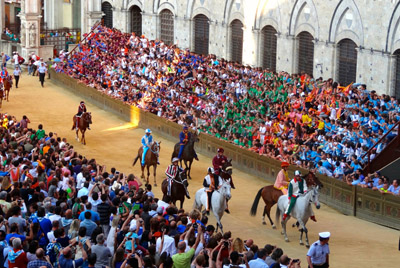 The night before the race, each contrada hosts a large party with sausages and good wine merrily looking forward to the fated day. To foster hope in their people, the
Capitano and the jockey of each contrada make valiant speeches predicting victory concluding with the special district hymn.
The night before the race, each contrada hosts a large party with sausages and good wine merrily looking forward to the fated day. To foster hope in their people, the
Capitano and the jockey of each contrada make valiant speeches predicting victory concluding with the special district hymn.
Race day begins with a special Mass, the Messa del Fantino (Mass of the Jockey), in the Cappella di Piazza (square chapel) offered by the Archbishop. After the Mass, the jockeys perform their final trial run around the track and return to their local churches to have their horses blessed by the local priest. After the short ceremony, the priest touchess a sacred relic in the horse's head and pronounces a formula - the same for every horse: “Va', e torna vincitore” “Go, and return victorious.”
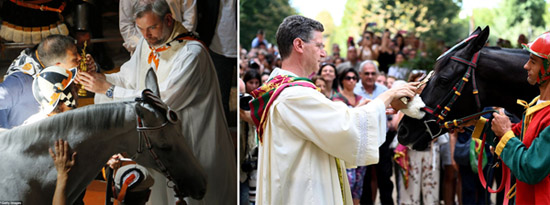 Next, a magnificent procession known as the Corteo Storico (historic parade) begins. The distinguished ladies and gentlemen of each contrada parade through the streets in their ceremonial garb. Each group is led by a drummer followed by two flag-throwers, a shield bearer, a standard bearer, two pages and a leader.
Next, a magnificent procession known as the Corteo Storico (historic parade) begins. The distinguished ladies and gentlemen of each contrada parade through the streets in their ceremonial garb. Each group is led by a drummer followed by two flag-throwers, a shield bearer, a standard bearer, two pages and a leader.
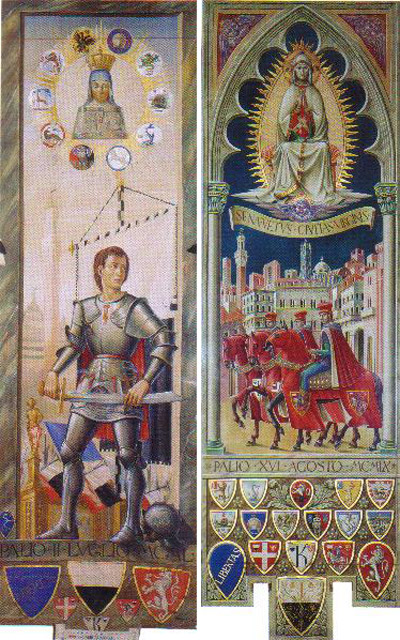 As the parade approaches the Piazza, bells toll and the Drappelione (insignia), a hand painted silk banner crowned with an image of the Blessed Virgin, which will be the prize of the victor, is carried around the Piazza on an ox cart accompanied by trumpeters, pages and four Provveditori di Balia (district judges).
As the parade approaches the Piazza, bells toll and the Drappelione (insignia), a hand painted silk banner crowned with an image of the Blessed Virgin, which will be the prize of the victor, is carried around the Piazza on an ox cart accompanied by trumpeters, pages and four Provveditori di Balia (district judges).
To bring the procession to a spectacular conclusion, two Alfieri (flag-turners) from each district perform to the beat of the drums and the judges, and dignitaries take their place in the stands where they will oversee the race. Such a display reveals the true prize for the victorious contrada: the blessing of the Queen of Heaven who reigns over the grand contest on the victory banner.
The local painters who make the banner must make a unique one each year that includes an image of Our Lady, Sienna's insignia, and colors and symbols representing the 10 contrade who participate in the race.
The onlookers wave the unique flag of each one’s particular contrada; the riders wear brilliant uniforms with the flag colors; everywhere is the life, color and distinction that marked the medieval ages. The resulting scene is magnificent with the Piazza filled with a dazzling entourage displaying each district's unique colors and customs. The beauty of the scene reflects the harmonic diversity that can exist in one city. Although the city is united in a common spirit, each one of its regions has its unique manner of expressing itself.
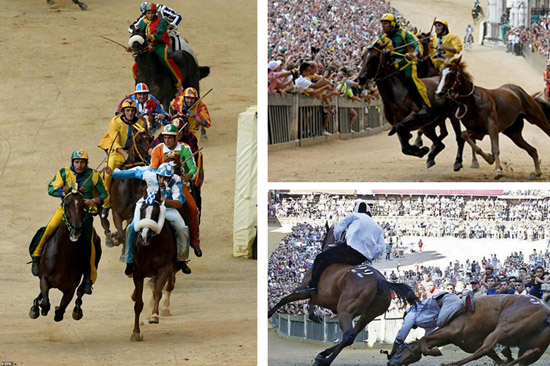 The race is an opportunity for the men of Sienna to prove their courage, because the riders must ride bareback on the slick and tuff-strewn stone streets of the Piazza with only a set of reigns and a racing whip. It is not a ride for sissies: Often the riders will whip each other and their horses in a bid to unseat their rivals.
The race is an opportunity for the men of Sienna to prove their courage, because the riders must ride bareback on the slick and tuff-strewn stone streets of the Piazza with only a set of reigns and a racing whip. It is not a ride for sissies: Often the riders will whip each other and their horses in a bid to unseat their rivals.
This grand festival is a good example of how a Catholic organic society can produce beautiful manifestations of local culture stimulated by a devotion to Our Lady. The people of Sienna of the Middle Ages desired to outwardly express their joy at the Assumption of Our Lady through the revelry of a gallant horse race.
The joy of the people from this city emanated to the country – and eventually to the world – as the fame of this celebration spread. Now, hundreds of spectators come to see this beautiful tradition and to experience the local pride and culture of a once magnificent city.
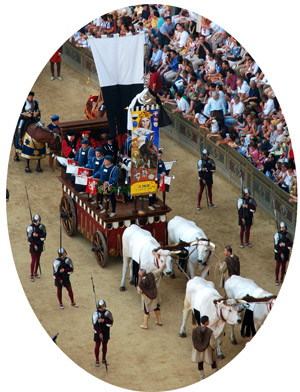

Posted August 19, 2019

A renaissance painting shows the grand parade of districts that opened the horse race; below, the crowds fill the plaza
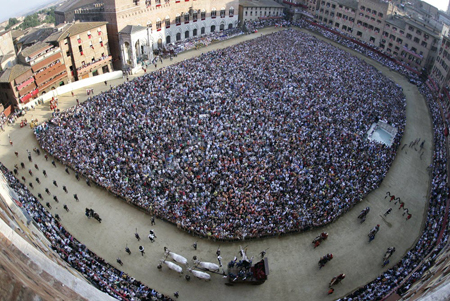
Each of the 17 contrade (districts) was formed organically as the different neighborhoods of the city were grouped around common churches, patron saints, trades and their histories. The contrade were given their names, symbols and flags to commemorate heroic acts of the people or memorable events.
One is the Contrada del Bruco (caterpillar district) whose inhabitants are specialized in silk, but they were given the title of nobility because of their heroism in defending Sienna from the Bohemians.
With such histories it is easy to understand why the people so passionately seek the victory for their contrada. This pride is carried into the races by the riders and bystanders alike as each man proudly dons his contrada's colors and ruthlessly calls for the defeat of the enemy contrade. This race also represents how the love of the medieval people for Our Lady found expression in colorful events. Let me look how it sprung up organically in this Italian city.

The Carabinieri in grand uniform precede the race
During the 13th century, the people desired to include the race in their celebration of the Blessed Virgin by moving the finish line to the Duomo Nuovo (New Cathedral), a cathedral dedicated to Santa Maria Assunta, and by offering candles and incense to the Virgin. In the 17th century, the race between the nobles was replaced by a race between the 17 contrade. The people of Sienna felt the need to express their devotion to Our Lady through these exciting bare back horse races through the city.
Preparations for the great race start a week before with the testing of the horses in the trial races. Thirty specially bred horses are brought before the mayor and the Capitani (Captains) of each contrada to decide which 10 horses will enter the race and to assign the horses to 10 contrade chosen by lot. The anticipation of the race draws many people to their local churches where they fervently pray for the victory of their contrada.

Each contrada has drummers and flag turners bearing its distinctive colors

Cheering is wild in the stands, each district with its own section and colors
Race day begins with a special Mass, the Messa del Fantino (Mass of the Jockey), in the Cappella di Piazza (square chapel) offered by the Archbishop. After the Mass, the jockeys perform their final trial run around the track and return to their local churches to have their horses blessed by the local priest. After the short ceremony, the priest touchess a sacred relic in the horse's head and pronounces a formula - the same for every horse: “Va', e torna vincitore” “Go, and return victorious.”

The priest's words express the vivacious spirit of the people:
Va', e torna vincitore - “Go, and return victorious”

The coveted prize - the Drappelione - a large banner displaying the Virgin Mary, different each year
To bring the procession to a spectacular conclusion, two Alfieri (flag-turners) from each district perform to the beat of the drums and the judges, and dignitaries take their place in the stands where they will oversee the race. Such a display reveals the true prize for the victorious contrada: the blessing of the Queen of Heaven who reigns over the grand contest on the victory banner.
The local painters who make the banner must make a unique one each year that includes an image of Our Lady, Sienna's insignia, and colors and symbols representing the 10 contrade who participate in the race.
The onlookers wave the unique flag of each one’s particular contrada; the riders wear brilliant uniforms with the flag colors; everywhere is the life, color and distinction that marked the medieval ages. The resulting scene is magnificent with the Piazza filled with a dazzling entourage displaying each district's unique colors and customs. The beauty of the scene reflects the harmonic diversity that can exist in one city. Although the city is united in a common spirit, each one of its regions has its unique manner of expressing itself.

An strong element of danger: riders use their whips; a riderless horses continues
the race and wins the race; bareback riders often fall
This grand festival is a good example of how a Catholic organic society can produce beautiful manifestations of local culture stimulated by a devotion to Our Lady. The people of Sienna of the Middle Ages desired to outwardly express their joy at the Assumption of Our Lady through the revelry of a gallant horse race.
The joy of the people from this city emanated to the country – and eventually to the world – as the fame of this celebration spread. Now, hundreds of spectators come to see this beautiful tradition and to experience the local pride and culture of a once magnificent city.

The banner of Our Lady paraded on
an oxcart for all to admire

Posted August 19, 2019





